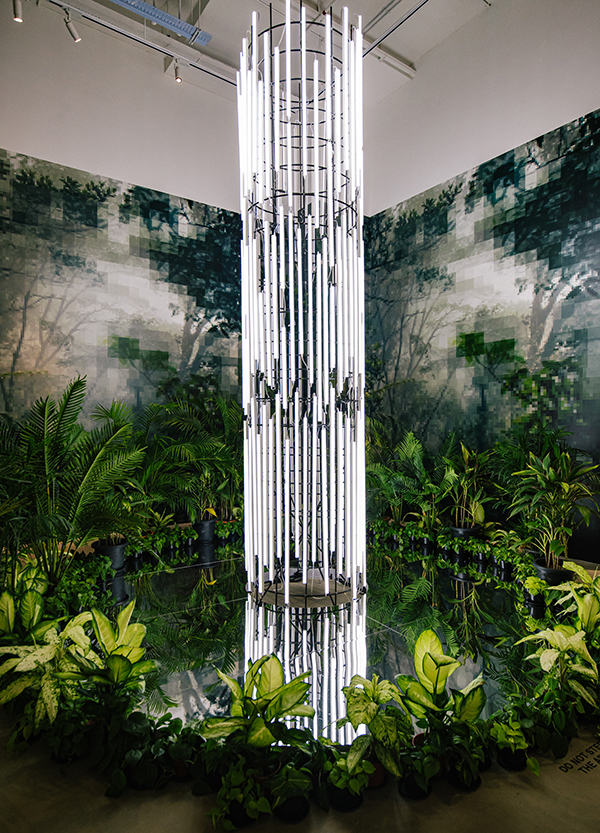
Photo Courtesy of Singapore Art Museum
Fountain of Interiors
Installation | 2022 | Rebars, Fluorescent Lights, Plants, Mirror, Wall Paper, Sounds
This installation work is commissioned by Singapore Art Museum for the exhibition Lonely Vectors, curated by You Mi, Kenneth Tay, Joella Kiu. By responding to the concept of zoning and foregrounding the capitalist desire to "interiorize" the world, this work reflects on infrastructural modernity, through both its rhetorics and violences.
This sculpture work resembles not a fountain but its inversion – a waterfall. The form takes references from the iconic Rain Vortex at Singapore's Jewel Changi Airport, which is named after HSBC, its sponsor. The HSBC Rain Vortex is a human-engineered waterfall, surrounded by rich tropical vegetation and contained within the air-conditioned environment of the Changi Jewel, one of the busiest airports in the world. As Peter Sloterdijk argues, globalization is a process of the interiorization of the world—not the elimination of the “outside,” but rather the absorption of the world into a carefully calculated interior, in which the physical space of the real globe is replaced by structures of points, lines and networks—a site of fetishization of movements which despatializes locations into directions. Airport is one of the vital nodes through which the despatlization was carried out. To have tropical nature without scorching heat encapsulates the aspiration of interiorization. The world interior does not only promise nature as comfort, but also profitable - at least as a spectacle of tourist attraction in the age of attention-monetization.
In this work, the form of the waterfall/fountain is also a point of interest. I see the waterfall as a fountain reversed - not only in its form, but in its affective connotation. In Many Undulating Things (2019), we examined a disappeared music fountain in Sha Tin, Hong Kong and how it inspired a sense of community, however elusive it was due to the nature of its location. If a fountain is often imbued with memories and meanings located in a particular space in time, its reverse is an invitation for awe and a statement of power that is capable to erase anything local.
The wonder of both fountain and artificial waterfall is also maintained by an invisible social technical system constituted by both machines and human labor. The infrastructural system is kept out of sight so that the world interior can be presented as natural and organic. In this work, the hue of white lights created by the piled light tubes resembles the hue of white lights commonly seen in carefully surveilled factories and storage houses as well as in migrant workers’ dormitories in Singapore. The violent intensity of the radiant lights embodies the invisible experiences of those who sustain the first world experience of comfort. As an inverted fountain, the work is also an attempt to foreground what is usually left outside of the frontal surface of how the benefit of globalization and modernity is experienced today.
This work was also exhibited at the 12th Seoul Mediacity Biennale THIS TOO, IS A MAP, Seoul Museum of Art, September 21-November 19 2023, curated by Rachael Rakes, with associate curator Sofia Dourron.





















